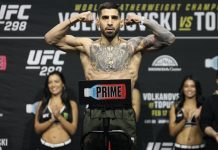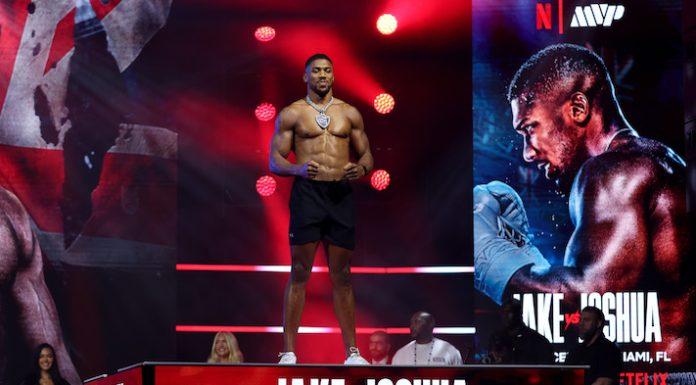If you want to learn a thing or two about weight cutting, listen to the guy who has thirty fights in the UFC. That would be Jim Miller, who makes it thirty-one against Charles Oliveira at UFC Milwaukee this weekend.
Milwaukee, WI — Every time Jim Miller steps in the octagon these days, he makes history. The first fighter to make it to thirty fights in the UFC, he’ll hit thirty-one walks to the octagon this Saturday at UFC Milwaukee. This time around, he faces Brazil’s Charles Oliveira, with a chance to improve his record to two straight wins, after snapping a four-fight losing streak against Alex White at UFC 228.
All that experience makes Miller a wealth of information when it comes to the fight game. And at Thursday’s UFC Milwaukee (UFC on FOX 31) media day, he turned his attention to the practice of cutting weight.
“When somebody misses weight I have mixed feelings about it, because there are things out of our control,” Miller explained to media outlets including Cageside Press. “Usually what happens is, they get a little too confident in their ability. But I’ve had things happen fight week where it’s like, the weight just doesn’t come off, for whatever reason. Maybe you ate something a little bit different, had a little bit too much salt, something like that. The weight just sticks.”
It’s not a fun process to begin with. It’s worse when things go sideways. “I’ve had a couple ones where, winding down, getting into Thursday night, it was like ‘oh, sh*t, I need to do a little extra work today and get in another session to get the weight cut,'” he continued. “And those ones suck. They really do. I don’t know how to explain it sometimes. There’s so many things involved.”
“You’ve got to control what you can control, and that’s just really the effort that you put into it, and the attitude that you approach it with,” Miller suggested. “It sucks, it really does.”
While Miller isn’t the type to quit on a weight cut, he’s also aware that some fighters have benefited from missing weight. “Unfortunately I feel like, there have been a lot of guys, and girls, fighters, that have been rewarded for missing weight,” he admitted. Which is not necessarily good for the sport, obviously. “That’s kind of the thing. Is taking these extra couple pounds off worth it? Because even though I come in over weight, if I win tomorrow, it could mean a title shot for me, or it could mean something big for me. It’s kind of just that, rewarding negative behavior, that we’ve created that a little bit.”
On the plus side, “the morning weigh-ins, I’ve said quite a few times, is probably the best thing that the UFC has done for us. It just gives us more time to relax.” No longer do fighters need to rush to get water and food in Friday evening before fight day, going to bed still bloated. Plus, it eliminated having to travel to the venue for weigh-ins while cutting weight, since the official weigh-ins are generally in the host hotel.
Miller has even considered a move up in weight, though his thoughts on that might surprise you. “I have thought about it. For a good period of time I walked around in the mid-180s. Mid to upper-180s. I felt physical benefits, when it came to grappling and also my power in the training room, when I was that heavy. But I couldn’t carry that into the fight,” he explained. At least not when cutting. “Then, probably because I was getting older, and also the other sh*t that I deal with, my weight cut started getting more difficult in like, 2015. So I decided to take some weight off. I’ve been walking around a few pounds lighter, I don’t get over 175 right now.”
The other issue he’s referring to is Lyme disease, which went undiagnosed for quite some time. Getting it under control helped get him back in the win column earlier this year.
In any case, Miller continued to give his thoughts on moving up in weight. Reiterating that he had thought about it, he explained that “the guys at 70 are big, but for me to feel those benefits, I would have to go up to 85.” Middleweight. After spending so much time at 155lbs. “I would just skip right over,” he continued. “I’d be fighting bigger men either way. For the majority of my career, I was training every day with my brother, who was an 85 pounder. So my game has always been to fight the bigger guy, use my speed, use my scrambling ability, stuff like that. Lately I’ve been training with a lot more small guys, so it would be harder for me to do that now. But I wouldn’t really, I’d still have to watch my weight a little bit. I’d like to put on a couple pounds if I went to 70, but then I’m still dealing with a weight cut.”
“So for me, I’d rather just walk around at that weight, step on the scale, and fight guys that are 210.”
165, the weight class many are pushing the UFC to introduce, wouldn’t even tempt him. Because, again, he’d still be cutting weight. “At the point where I’m at right now, I’d probably still stay at 55.”
As for dropping to featherweight, that’s out too, since “I’d have to walk around at about 160, because it would take a long time to get there, to remove the muscle and to really slim down.”
What Miller would like to see, ultimately, is weight cutting become more regulated. “I’d like to see hydration tests, honestly. If you’re talking about fighter safety and our ability to perform.” As he pointed out, “even if you throw in the extra weight class, and move 70s up to 75, you’re still going to get guys that are cutting. And then for that opportunity to be fighting in two weight classes and potentially be champ in two weight classes, you’re going to see even more jumping around between weight classes I think, in that span between 55 and 85.”
USADA, Miller suggested, could be leveraged for those hydration tests. After all, they’re testing fighters several times a year anyway.
Mind you, it’s unlikely Miller is about to make the move up in weight, when all is said and done. At 35, he’s taking things one fight at a time. But it’s food for thought, and maybe a lesson to be learned for younger fighters coming up.
Jim Miller faces Charlies Oliveira on the main card of UFC Milwaukee (UFC on FOX 31) on Saturday, December 15 at the Fiserv Arena in Milwaukee, Wisconsin. The card airs on FOX (CTV2 in Canada) starting at 8PM EST.





















